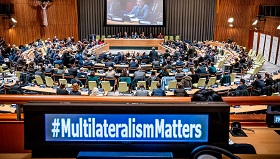The recent COVID-19 pandemic outbreak marked a severe blow to the world system, no government excluded, revealing itself as one, if not the greatest crisis ever faced after World War II. And while some governments coped better than others with the emergency, no one was spared. Besides causing a considerable number of casualties, the virus coincidentally revealed already existing problems, emphasizing the weaknesses and limitations of some of the major governing institutions. More precisely, the virus had a profound impact on the European Union, shedding light on the old dichotomy National vs. European Identity. Alongside the health crisis and the ensuing economic one, Europe is now conjointly faced with an identity emergency.
By initially favoring national lines of conduct to solidarity, the behavior of some EU member states highlighted a lack of confidence in the community’s operate itself. Evidence includes the recent Eurobarometer survey, according to which EU support registered a drop, especially during April. In Italy, for instance, EU support fell by 16%, reaching one of the lowest levels ever registered. Furthermore, conforming to the data, the COVID-19 outbreak is stated to have weakened the Union, with Italy, France, and Germany being the main supporters asserting that Brussels would not have done enough to support their countries during the crisis. Rather than evidencing a novel phenomenon, however, it would be more appropriate to see this as the latest manifestation of a long-standing issue: namely the lack of "Europeanness", a strong sense of identity binding the EU community together.
If the health emergency represented an unprecedented situation for the European community, the lack of trust in its institutions did not. The existential crisis, as the former president of the commission, Jean-Claude Junker described in 2017, has been going on for a long time. "Never before have I seen such little common ground between our Member States. […] Never before have I heard so many leaders speak only of their domestic problems." From the 2008 financial crash to the refugee crisis, to the rise of populism and extremism to eventually Brexit, Euroscepticism saw a continuous and consistent surge over the years.
What Defines European Identity?
In its broader sense, identity can be classified by its disruptive element, distinguishing those who are part of the group ("we-feeling" [1]) from those who are not; in this case, EU vs. NON-EU. Conversely, with regard to European identity specifically, two intrinsic elements are identified: plurality and individuality [2]. Plurality refers to the sense of belonging to a community that shares a common culture, values, and history, "a nation comprising several" (Montesquieu). Conversely, individuality stems from the strong regional and individual national identities present on European soil. It is from these two intrinsic elements that Europe will generate its own identity, finding its way between the global and the local [3]. The two aspects are not mutually incompatible. In an example given by Halbig, reference is made to the French regions of Alsace and Lorraine, both of which are very strong in terms of regional identity but also very active in terms of European sentiment.
Why is The Development of a Shared Identity so Fundamental?
According to Paul Collier, professor of Economics and Public Policy at Oxford University, at the root of any economic development lies a sense of identity [4]. Every society presents a dual composition, a power structure, and an identity component. In the absence of the latter, power dissolves into a theatre, meaning directives are less likely to be respected (e.g., different member states' response to the refugee crisis). When considering the EU, a mismatch between the power structure (supra-national) and the identity component (national) is observed. In order for the Union to work more efficiently, therefore, a move of the identity component, at present almost exclusively national, toward the structure of power is suggested. Such approach does not equate to the erasure of national identity, an essential element at the core of the European Union, as evidenced by its motto "United in Diversity." Furthermore, as already stated, National and European identities are classified as not exclusive to one another, meaning the presence of one does not exclude that of the other, with the supra-national identity constituting a powerful addition to the national one [5]. While, at the individual level, identity drives behavior, at the supra-national dimension, a sense of belonging to the same community will serve as a prerequisite for further growth, for it will foster future trust and simplify cooperation [6] .
As further proof of the lack of a sense of collective identity, Eurobarometer surveys will now be taken into account. When analyzing the data, particular interest is given to the "Moreno question [7]" section. If the fact that the values collected do not show any particular changes over the last twenty years could, at first glance, be interpreted as a positive variable, it is precisely the lack of growth itself that sets the alarm bell off. Moreover, whilst at the European level values have remained nearly unchanged, at the individual state levels, data shows to have undergone some changes. A significant disparity is registered among different countries, a variable that has changed over time. Among the EU founding members, France and Italy registered a drop in EU identification. Severe variation is also reported on the basis of different socio-economic and demographic factors at an individual level. Those variables include age, level of education, occupation, socio-economic condition, etc. Not very surprisingly, the group more likely to show a higher level of identification with the European Union is composed of young, relatively wealthy, well-educated, eager to travel, work and study abroad people. Namely, those who had had the opportunity to experience free mobility at first hand, along with its benefits.
What are the Processes Through Which Identity is Created?
Before embarking on the policies employed to meet the European challenge, it is necessary to define the processes through which identity is created. In determining the mechanism through which identity is created, two distinct paths are distinguished: information-based and experience-based components [8]. Information-based mechanism rests on the effectiveness of convincing messages as a source of group identification, as well as on the level of accessibility and exposure citizens get from those messages. Messages' supply will rely on the political elite as well as the media outlets. At the same time, exposure to Europe-related information will be more dependent on the level of attentiveness and interest dedicated by citizens to such type of message. Conversely, experience-based mechanisms lie on the idea of personal contact and direct experiences as a source of identification. Increased contacts and personal connections (e.g., Erasmus exchange program) are said to have an impact on group members' perceptions.
What are the Problems at the Root of the European Identity Crisis?
To adequately respond to the current crisis due to the European Union's lack of identification, it is necessary to become more familiar with the underlying problems of this trend. Of particular interest in this respect appears the European Research Project PERCEIVE. The project's scope lay in the investigation of Cohesion Policy in creating a shared sense of European identity and a broader adherence to Europe's values among citizens. The policy (2007-2013, 2014-2020) aimed at eradicating inequalities among member states, as well as at the development of a sense of belonging to a shared community. Although the research was explicitly tailored to the European Plan's success, the identified issues appear to carry a much more general nature. In particular, three major problems were identified.
The first issue to be identified lies in communication. According to findings, one of the reasons why the European Plan proved to be unsuccessful in gaining support for Brussels derived from the way it has, or better, has not, been presented by local governments and media outlets, namely how much coverage was dedicated to EU-related information. When working toward the implementation of a sense of belonging, Europe must thus learn to communicate its policies better. In this regard, communication channels, social media platforms included, appear crucial.
Secondly, it was noted that the allocation of structural funds does not necessarily equate with a rise in EU support, nor with a surge in identification with the community. In this regard, reference is made to Calabria (Italy). Although a large amount of funds was allocated to the region, 34% of the respondents still viewed their country’s EU membership negatively. According to the researches in order for funds to create support, they do not only need to be allocated, but also, they need to be spent well, as well as promoted in relation to the results obtained.
Lastly, the third problem to be identified related to awareness. When asked about the EU Cohesion Plan, less than 50% of EU citizens surveyed were familiar with the EU Cohesion Policy. The finding suggests that being unfamiliar with EU Policies and Initiatives at a broader level, citizens will likely not be aware of the benefits they provide, hence the importance of raising awareness.
What Kind of Initiatives Have Been Employed to Promote a Sense of Identification in the European Community?
In outlining the strategies implemented by Brussels aimed at developing further cohesion between member states, two different identity components need to be further distinguished: civic and cultural [9]. The distinction appears useful as it allows us to distinguish two different lines of action to implement the policies of identification with the European Union.
A European "Civic Identity" would, therefore, refer to the perception to be part of a European political system, defining rules, laws, and rights concerning the individual citizen's life. When targeting the civic component, European initiatives should thus aim at generating a sense of communal participation in the Union's decision-making processes, stressing the involvement of one common political system. The primary purpose, more generally, should, therefore, consist in making institutions more efficient and transparent, as well as more accessible to European citizens. The result would lead not only to greater participation in European political life but would also increase citizens' awareness of the European institutions as well as of the benefits to which they have access. Among the European initiatives that have been undertaken in accordance to these lines are the following: European Parliament's elections, citizen's project initiatives and dialogues, a common passport, uniformed license plates, free mobility, free-roaming, MEP (Model European Parliament) and the EU-wide job agency (EURES).
In contrast, "Cultural Identity" is defined as the component, independent from the above-mentioned political perceptions, stemming from the idea that Europeans are closer than non-Europeans due to a rich set of shared values, as well as a shared culture and history. By emphasizing the commonality derived from a shared past between EU members, initiatives will be implemented in order to raise a sense of alignment between citizens of the same group. Examples include Erasmus+, free interrail tickets, town twinning programs, European Capital of Culture, a pan-European TV Channel (Euronews), as well as shared symbols, such as the European Flag, European Anthem, a common motto ("United in Diversity"), and a shared festivity, Europe's day (9 May).
Reshaping the EU, What Can be Done in Order to Develop a Sense of Identification?
Following the Italian unification in 1861, Massimo d'Azeglio, Italian politician and writer, said, "once Italy was made, now we must make Italians." And the same logic applies to Europe. Being a relatively young system, not even 70 years old, and undergoing continuous development, in order for Europe to act more efficiently, proper attention must be paid to policies aimed at implementing a shared identity, rather than focusing solely on its economic aspect. In this regard, as already mentioned, the discrepancies recorded in the various Eurobarometer surveys appear of particular interest.
More specifically, as suggested in a recent report published by ECONPOL, "What a feeling?! How to promote European Identity", experts identified in adults, pensioners, and more generally less socio-economically advantaged people the main targets of a new identity plan. According to surveys, these categories have proved to be the least likely to develop a sense of EU cohesion, hence the need to focus on them. While young, well-educated, and generally wealthy people tend to present higher trust rates, mainly due to the free movement policies allowing students and young professionals to create valuable transnational contacts, staying at home and being exposed to European tourists does not seem to have the same effect. According to experts, in order to create a more inclusive identity, more focus should be put on those people less likely to experience the benefits of their country's EU membership.
In addition to providing a list of possible targets to be included in a potential new plan for the development of a European identity, several suggestions were presented in the report. These suggestions will be listed below, distinguishing between their civic and cultural dimension.
Among the suggested civic initiatives, we find the creation of supranational party lists. The idea is not entirely new, as several politicians have already proposed such a plan, including the French President Emmanuel Macron. According to scholars, the creation of supranational lists would guarantee a more pronounced loyalty to the party's key idea, resulting in a greater party accountability. Simultaneously, the existence of transnational parties could generate more public interest and contribute to greater participation in parliamentary elections. Secondly, among the various propositions, the establishment of European embassies is presented. Such offices would provide consular services for all EU citizens, while foreign policy would remain of national competence. Working at a supranational level would hence contribute to the message of a more present and helping Europe. At the same time, their creation would ensure consistent money-saving as well a higher level of efficiency, resulting from the standardization of the procedure. Finally, city assemblies, where citizens could meet to discuss European issues, the content of these meetings then being brought before the EP, are also proposed. This practice, already in use in Ireland, would thus increase the sense of citizen involvement.
Simultaneously, from a cultural point of view, several initiatives are also suggested. Among the most significant ones, we mention the creation of different exchange programs targeting adults (European Waltz), to create an on-the-job experience exchange, as well as pensioners (Pensioners' Erasmus), to support those eager to learn and get to know more about European countries and their cultures. Concurrently, the creation of an EU Public Service Broadcaster, active in several EU languages, and thus facilitating access, is proposed. The platform would air daily, covering EU-related news as well as all public meeting and hearings of European Institutions. In order to meet its purpose, the broadcast should present a high degree of independence from politics, providing its viewers with objective information.
Conclusion
Rather than being regarded as a threat to one's identity, fostering European unity should instead be perceived as a benefit. A "community of communities"[10] working together for a common good. If, in accordance with the theory of social constructivism, social processes are at the core of the construction of ideas, then the legitimacy of the European Union itself will also be partly defined by the existence of a strong European identity. As opposed to being merely regarded as a challenge, COVID-19 pandemic provides all the necessary elements to be the turning point Europe needed to reshape its position. Besides addressing health and socio-economic issues, institutions should also focus on fostering a shared EU identity.
On 13 December 1973, the then Nine Member States signed the European Declaration of Identity in Copenhagen. Although the document was drafted almost 50 years ago, some of the directives remain relevant today. When assessing the extent to which the Nine were committed to working together, European unity was praised as the basic necessity to ensure the survival of the civilization they had in common. At the same time, legal, political, and moral national orders were stated to be preserved. (ART 1). Furthermore, to ensure the respect of national identities, diversity was praised as the fundamental element giving the community its peculiarity and dynamism (ART 3). When addressing the current geopolitical issues, the Nine reaffirmed their willingness to act together as a large community. A community that, in order to fulfill its aims, cannot only be economic. (ART 7).
"Although in the past the European countries were individually able to play a major role on the international scene, present international problems are too difficult for any of the Nine to solve alone. International development and the growing concentration of power and responsibility in the hands of a very small number of great powers mean that Europe must unite and speak increasingly with one voice if it wants to make itself heard and play its proper role in the world." (ART 6)
"Unite and speak increasingly with one voice," suggesting that in order for a system to function correctly, it needs to be accompanied by a great sense of cohesion and belonging.
1. Easton D. A system analysis of Political Life (1965).
1. Halbig, T.E., (2019) Creating an European Identity, Volume 4 pages 75-79.
2. Chopin T. (2018) Europe and the identity challenge: who are “we”?, Robert Shuman Policy papers.
3. From Poverty to Prosperity: Understanding Economic Development, Paul Collier, Blavatnik School of Government, Oxford University.
4. Troitino, D.R. (2009) Creation of European Identity in the European Union, https://www.researchgate.net/publication/330712624_Creation_of_European_Identity_in_European_Union_Creation_of_European_Identity_in_European_Union.
6. Ciaglia, S., Fuest, C., Heinemann, F. (2019) What a feeling?! How to promote European Identity, ECONPOL.
7. In the near future, do you see yourself as: (1) [nationality] only, (2) [nationality] and European, (3) European and [nationality, (4) European only.
8. Bergabauer, S. (2018) Explaining European Identity Formation.
9. Bruter, M. (2003): Winning Hearts and Minds for Europe. The impact of News and Symbols on Civic and Cultural European Identity.
10. Damaso, M., Davies, L.J., Jablonowski, K., Montgomery S. (2019) Acting European, Identity belonging and the EU of tomorrow.









